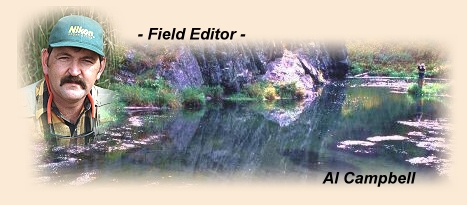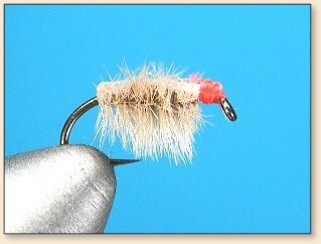|
First of all, I didn't invent this pattern. I saw
it tied on the Bighorn River over a decade ago. I
was actually a bit amazed that it was so easy to tie
and even more amazed at how well it caught fish.
As far as the name goes, one legend has it that the
name refers to the idea that even a blind fish could
spot this fly. Another legend has it that even a
blind fisherman could catch a fish with this pattern.
I don't care which is the truth. If it catches fish,
and is easy to tie, I like it. It does, and it is,
so I'm fond of this pattern.
This fly is supposed to represent a scud or sow bug.
It does a great job of it. I have seen maybe two
dozen versions of the Ray Charles, and all of them
work fine. Most have some type of ribbing to hold
the back in place and make the fly more durable, but
the fish don't care if it is a simple version or not.
Neither do I.
Body colors vary a lot, but gray, orange and pink
are the most common colors. For the Bighorn, sizes
range from about size 14 to 18. Size 18 to 22 are
productive in the Black Hills streams, so don't limit
yourself. Using a nymph net in your local waters
should help you identify the most common sizes for
your area.
Too Simple Ray Charles
List of materials:
- Hook: - Any standard nymph or wet fly
hook size 12 to 22, even cheap ones will do. I'm
using a size 16 Mustad 3399A hook.
- Body: - Ostrich herl, 2 to 4 strands
depending on hook size, I'm using 3 strands for a
size 16 hook. I'm using gray, but pink, orange
and other colors work well.
- Legs: - Same as body, actually part
of the body.
- Thread: - 6/0 - Any color works, but
bright red, pink or orange seem to work better.
- Back: - Pearl tinsel, fairly wide.
- Rib: - None, except for the guys who
can't tie a fly this simple. For those guys rib it
with wire if you must. Of course, then it wouldn't
be a too simple fly.
Tying steps:
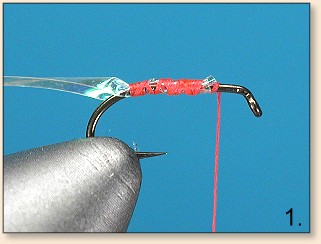
1. Start the thread and tie the tinsel to the hook.

2. Add the ostrich herl.
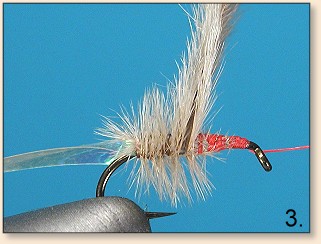
3. Start wrapping the herl. This is a
lot easier with a rotary vise, but any vise
will do.
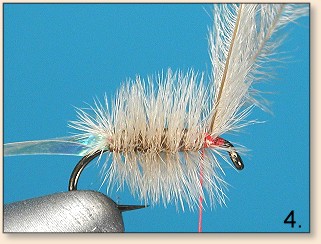
4. Wrap to behind the hook eye and tie off
there, leaving plenty of room for a head.
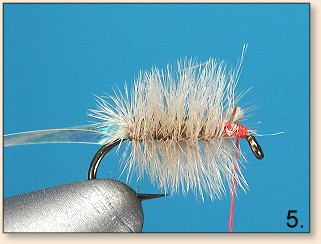
5. After tying off, trim the excess herl.
No need to be perfectly neat here, the top of
the fly is covered.
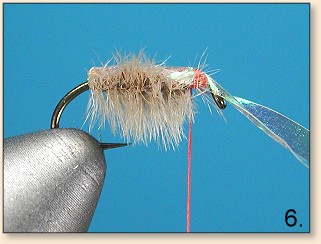
6. Pull the tinsel over the back of the fly
and tie off near the hook eye.
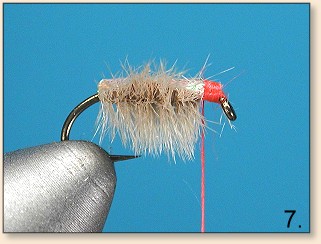
7. Trim the tinsel and make a fairly decent
head of thread. When tying for speed, I don't get
too anal about how neat the head looks as long
as it's tight.
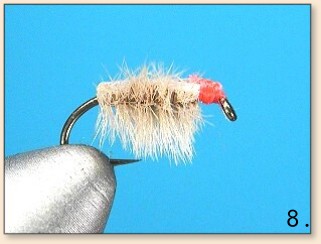
8. Whip-finish and cement the head. You're
finished.

9. From the top your fly should look something like this.
Since midges are very common, and their larvae
are often bright red, I think the bright red
head is often a trigger mechanism to the fish
that cause them to take this fly. I have tried
other thread colors but bright red has been more
productive than the rest. Your experiences,
however, might vary from mine. One thing is
certain, this pattern catches fish. It's also
too simple to ignore.
For all you guys who think a fly has to be more
complex than this, go ahead and rib it with gold
or copper wire if you wish. You might even want
to make the head prettier than I do. It won't
bother me a bit if you do. I'll be fishing.
~ AC
|
